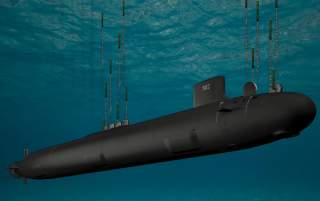The U.S. Navy’s New Missile Submarine Might Be a Bad Idea
Submarines are expensive. And they’re getting easier for enemy forces to detect. A robotic surface ship might make a better missile platform.
The U.S. Navy is about to lose a big chunk of the missile tubes it relies on to fire Tomahawk land-attack missiles during wartime.
The four SSGN cruise-missile submarines that the Navy converted from Ohio-class ballistic-missile boats are slated to decommission in the mid-2020s. These four boats, each packing 154 missile tubes, together account for 600 of the fleet’s roughly 6,000 Mark 41 launchers that fire Tomahawks.
The fleet’s plan to mitigate that 10-percent loss of Mark 41 tubes could jeopardize its ability to battle Chinese and Russian forces. That’s because the Navy is counting on enhancements to a new version of the Virginia-class submarine partially to replace the SSGNs.
But the Virginias might not be the best platform for land-attack, experts told Defense News. Submarines are expensive. And they’re getting easier for enemy forces to detect. A robotic surface ship might make a better missile platform, the experts said.
The Navy in late 2019 is preparing to sign a potentially $20-billion contract with shipbuilders for 11 copies of the Block V Virginia, which adds new missile tubes to boost each boat’s Tomahawk load from 12 missiles to 40.
The 11 Block V boats together would function as partial replacements for the four SSGNs, buying the Navy time to plan for a new SSGN class that could enter service in the 2030s or 2040s.
But it’s a waste to equip the new submarines for land-attack missions, Bryan Clark, a retired submariner and fellow at the Center for Strategic and Budgetary Assessments in Washington, D.C., told Defense News.
“I think the requirement may be changing,” Clark said. “Over the past 10 years there has been a real emphasis on the submarine as the one tool we have that may be able to get into contested areas — the East and South China seas, up in the North Atlantic, et cetera.”
“That’s changing now,” Clark added. “These countries are investing in their own anti-submarine warfare systems. China has put a lot of money into ASW systems, they are installing surveillance systems akin to our SOSUS [sound surveillance system]. So the idea that our submarines are our go-to asset to gain access, that may not be true in the next few years as it was in the past 10, so there is a question as to whether we should be investing in submarines to maintain the undersea strike capacity.”
Clark proposed that the Navy add missiles to surface ships, including inexpensive unmanned vessels that could function as floating arsenals.
Jerry Hendrix, a retired naval flight officer and analyst with The Telemus Group, agreed with Clark’s assessment. The argument for surface-based land-attack capabilities grows more compelling as the Navy develops large, hypersonic strike missiles that could help the fleet to strike targets from beyond the range of Chinese anti-ship ballistic missiles.
A hypersonic missile most likely would not fit in a Mark 41 tube, requiring the Navy to make pricey alterations to any ship that the service wants to carry the new, super-fast munition.
“I think there is a powerful argument to distribute these weapons across the surface force,” Hendrix told Defense News. “If you can create a strike weapon that allows the surface force to stand outside of DF-21 and DF-26 [anti-ship ballistic-missile] range and shoot three-pointers from outside, then yes. To create mass and volume in the submerged force is twice to three times as expensive as it is to create that volume from the surface force.”
“So there is a solid argument just from the standpoint of cost,” Hendrix stated. “If I was trying to create 2,000 tubes of hypersonics — which are much more massive than Tomahawks, won’t fit into a Mark 41 vertical launch system and hence will have to go into a different configuration — to create that mass in the submerged force is going to be very expensive.”
A third expert endorsed the idea of a robotic surface vessel relieving submarines of their responsibility for carrying land-attack missiles into combat. “I think this is going to one of the main things driving the design of the large unmanned surface combatant,” Dan Gouré, an analyst at the Lexington Institute think tank in Washington, D.C., told Defense News.
David Axe serves as Defense Editor of the National Interest. He is the author of the graphic novels War Fix, War Is Boring and Machete Squad.
Image: Electric Boat.

